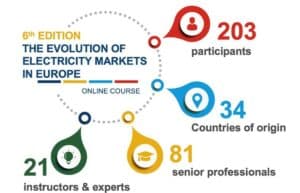Read the best papers of our Alumni from ‘Evolution of Electricity Markets in Europe’
During the 2022 edition of the course, participants were offered the possibility to apply the knowledge they acquired by working on a European real life case. The best papers were selected to be featured in the FSR Knowledge Hub.
For the 2022 edition of our community course Evolution of Electricity Markets in Europe, participants were given the opportunity to take a Mastery Challenge and analyse current issues in electricity markets. Each group could choose to work on one of the subjects proposed by our instructors: 1) From short-term interventions to medium or long-term changes to the electricity market design after the crisis; 2) The future of capacity remuneration mechanisms; 3) Demand-side flexibility.
At the end of the course, one excellent paper for each topic was selected to be featured in our FSR Knowledge Platform. The best works were picked considering the knowledge of the topic displayed in the paper, the ability to think creatively/critically and the quality of the text. After this 8-week learning experience, participants were able to evaluate the alternative solutions and formulate proposals that were discussed by a panel of experts during the final live classes.
Check out below the abstracts of the winning papers and read the full texts.
From short-term interventions to medium or long-term changes to the electricity market design after the crisis
Final paper by Katherine Daman, Olivier Megel, Valbona Kaparici, Pedro Amaral Jorge, Olivier De Block
In this paper, first we set the stage with a review of the causes of high energy prices affecting the EU as of mid-2022 and especially the natural gas price surge until today. Secondly, we reviewed the measures taken by different countries in order to counter the high consumers energy bills and compare those with the EU toolbox and how they may deviate from it. Finally, we proposed a set of recommendations to strengthen the tools available or implement new ones for the short, mid and long-term, aiming at protecting households from energy prices volatility.
The future of capacity remuneration mechanisms
Final paper by Rodrigo Mangas Calvo, Annette Jantzen, Grace Burke
This paper aims to explain the main causes that prompted the European legislation to address the issue of Capacity Remuneration Mechanisms (CRMs). The paper also analyses why CRMs are still needed, even when the Clean Energy Package reform considers CRMs as a last resort mechanism. The paper argues that both the missing money and the missing market arguments still hold, and that the recent (2022) market interventions indicate that these issues will not be solved in the near future. In the last part of the paper, different CRMs across Member States are explored, showing the diversity of approaches followed in Europe. Finally, general conclusions are drawn, including ideas for the design of a hypothetical CRM.
Demand-side flexibility
Final paper by Valentyna Diatlovska, Giulia Gamberi, Vitalii Opryshko, Mano Panousis, Yan Tsymablyuk
This paper addresses the option of demand-side flexibility in the context of the evolution of the electricity market in Europe. The first section of the paper briefly outlines the potential of demand side flexibility throughout the world markets. In the second section of the paper are explored the main obstacles and open issues that limit the full scope application of demand response for flexibility needs. Key barriers and requirements for flexibility products implementation are presented. Possible solutions are presented in the third section, based on the principles and market procurement models for flexibility, set jointly by transmission and distribution system operators. In this context, section four provides an overview of ACER Framework Guidelines for demand-response. The focus is on the aspects to be standardised at the EU-level to create a level-playing field for the flexibility providers. Finally, the recommendation on the options for system operators to access flexibility is proposed.
About Evolution of Electricity Markets in Europe
The sixth edition of Evolution of Electricity Markets in Europe set a new record of participation: 203 professionals, from 34 different countries all over the world, joined this online course to gain insights on how European electricity markets have evolved from the onset of liberalisation until today.

This training course, developed in collaboration with the European Commission, ACER, and ENTSOE, consisted of 8 weeks of online activities and live classes. During this learning journey we covered topics related to the transmission level as well as to the distribution level. One week was allocated to deep dive into the Regulation on Wholesale Energy Market Integrity and Transparency (REMIT), thanks to the participation of legal specialists. The course concluded with two final weeks fully dedicated to the group works, which were reviewed and commented by a Panel of Experts for each topic of the Mastery Challenge.
During this training, participants were offered a personalised learning experience where they could decide their level of engagement in the course and the time they wished to dedicate to the several activities proposed on the course platform. Beside quizzes with instant feedback, participants could engage in weekly discussions with the instructors and their fellow colleagues, sharing their knowledge and experience on the course topics. In addition, for selected weeks of the training, dedicated course texts were created in the form of collaborative documents, in order to give participants the possibility to provide their contributions to academic reading materials.
Thanks to this course I acquired up-to-date knowledge that broaden my understanding of the current energy market design and its further development.
For the course members who were willing to apply their comprehension of EU electricity markets built-up in the previous weeks, we offered the opportunity to tackle a European real life case by signing up for the group Mastery Challenge and have their proposals heard by the decision-makers in Europe.
Learn more about this course






